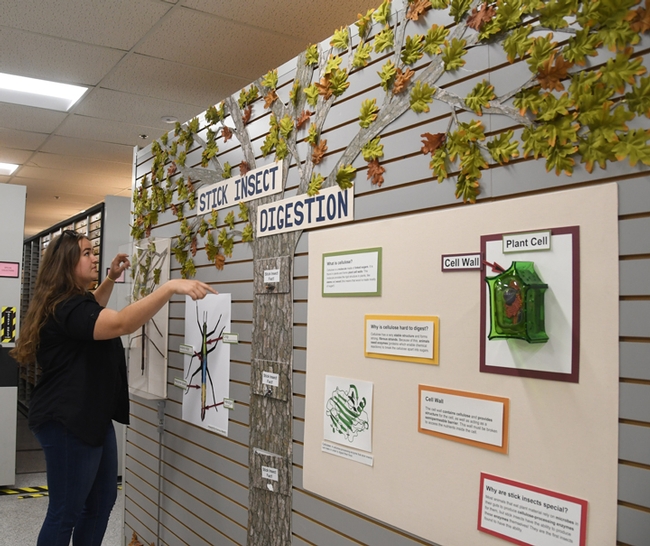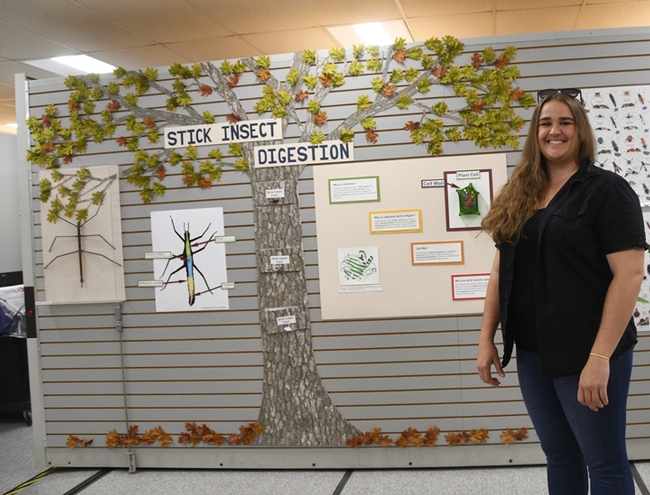- Author: Kathy Keatley Garvey

A new display, designed and coordinated by Bohart associate and UC Davis biological sciences graduate Emma Cluff, showcases stick insects and insect digestion. A research grant donated by Brian Johnson, associate professor of entomology, funded the project.
“I have always thought stick insects were pretty amazing,” said Cluff, who worked on the project over a six-month period. “I loved making the display visually catching as well as informative. I spent a lot of time reading papers and communicating with graduate students who worked with Brian Johnson, and I enjoyed figuring out how to translate their science into terms that the public would find accessible.” The Johnson lab studies the genetics, behavior, evolution, and health of honey bees and currently focuses on the evolution and genetic basis of social behavior using comparative and functional genomics.
Stick insects, most abundant in the tropics and subtropics, belong to the order Phasmatodea and are found on all continents except Antarctica. They derive their name from the ancient Greek “Phasma,” meaning an apparition or phantom, referring to their resemblance to sticks or leaves.
The finished project, mounted on a wall, includes a wood sculpture of a stick insect by Leo Huitt of Woodland, and illustrations by UC Davis entomology student Karissa Merritt, who drew the anterior midgut, Malpighian tubules, crop and hindgut. The display also includes stick insect facts, with lift off tabs.
“People seem surprised that we know so much about stick insect digestion,” Cluff commented. “Visitors have also commented on how incredible it is that a fairly complex digestive system can fit in such a slender organism.”
In her display, Cluff explains cellulose and why it is difficult to digest. She defines cellulose as “a molecule made of linked sugars. It is found in plants and forms plant cell walls. This moleculre provides the rigid structure in plants, like stems and wood (this means that wood is made mostly of sugar!)”
Why is it difficult to digest? “Cellulose has a very stable structure and forms strong fibrous strands. Because of this, animals need enzymes (proteins which enable chemical reactions) to break the cellulose apart into sugars.”
This was her first experience designing an exhibit. “It was a really wonderful experience,” she said.
“Emma is very talented and I would really like to see her continue doing science outreach,” said Lynn Kimsey, director of the Bohart Museum and professor of entomology at UC Davis.
Cluff, from Turlock, plans to attend graduate school and become a marine biologist. “I love marine bio and I am also passionate about education so I would like to somehow combine the two. I always loved marine science as a kid, and taking a research course at Bodega Bay re-inspired me. I think marine science is so important for the future of our planet, and I also fell in love with research and the creativity of it.”
The Bohart Museum is located in Room 1124 of the Academic Surge Building on Crocker Lane. It is the home of nearly eight million insect specimens, plus a live “petting zoo” that includes stick insects, Madagascar hissing cockroaches, tarantulas and praying mantids; and a year-around gift shop.
Richard “Doc” Bohart (1913-2007), former professor and chair of the UC Davis Department of Entomology (now the Department of Entomology and Nematology), founded the insect museum in 1946.
The Bohart Museum is open to the general public Mondays through Thursdays, from 9 a.m. to noon and from 1 to 5 p.m., plus occasional, weekend open houses. Admission is free. The next weekend open house is from 1 to 4 p.m., Sunday, Nov. 18 and centers around urban entomology..
Further information is available on the Bohart Museum website at http://bohart.ucdavis.edu/ or contact (530) 753-0493 or bmuseum@ucdavis.edu.




